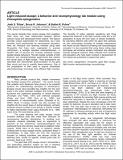Files in this item
Light activated escape circuits : a behavior and neurophysiology lab module using Drosophila optogenetics
Item metadata
| dc.contributor.author | Titlow, Joshua S. | |
| dc.contributor.author | Johnson, Bruce R. | |
| dc.contributor.author | Pulver, Stefan R. | |
| dc.date.accessioned | 2016-02-18T11:10:05Z | |
| dc.date.available | 2016-02-18T11:10:05Z | |
| dc.date.issued | 2015-07-07 | |
| dc.identifier | 194346593 | |
| dc.identifier | d270dc2c-a60f-44c5-a0fc-780b6a935aaf | |
| dc.identifier | 84940752965 | |
| dc.identifier.citation | Titlow , J S , Johnson , B R & Pulver , S R 2015 , ' Light activated escape circuits : a behavior and neurophysiology lab module using Drosophila optogenetics ' , Journal of Undergraduate Neuroscience Education , vol. 13 , no. 3 , pp. A166–A173 . | en |
| dc.identifier.issn | 1544-2896 | |
| dc.identifier.other | ORCID: /0000-0001-5170-7522/work/69463447 | |
| dc.identifier.uri | https://hdl.handle.net/10023/8256 | |
| dc.description.abstract | The neural networks that control escape from predators often show very clear relationships between defined sensory inputs and stereotyped motor outputs. This feature provides unique opportunities for researchers, but it also provides novel opportunities for neuroscience educators. Here we introduce new teaching modules using adult Drosophila that have been engineered to express csChrimson, a red-light sensitive channelrhodopsin, in specific sets of neurons and muscles mediating visually guided escape behaviors. This lab module consists of both behavior and electrophysiology experiments that explore the neural basis of flight escape. Three preparations are described that demonstrate photo-activation of the giant fiber circuit and how to quantify these behaviors. One of the preparations is then used to acquire intracellular electrophysiology recordings from different flight muscles. The diversity of action potential waveforms and firing frequencies observed in the flight muscles make this a rich preparation to study the ionic basic of cellular excitability. By activating different cells within the giant fiber pathway we also demonstrate principles of synaptic transmission and neural circuits. Beyond conveying core neurobiological concepts it is also expected that using these cutting edge techniques will enhance student motivation and attitudes towards biological research. Data collected from students and educators who have been involved in development of the module are presented to support this notion. | |
| dc.format.extent | 1781867 | |
| dc.language.iso | eng | |
| dc.relation.ispartof | Journal of Undergraduate Neuroscience Education | en |
| dc.rights | Copyright © 2015 Faculty for Undergraduate Neuroscience. Reproduced with permission by the publisher. The final published version can be found here: http://www.funjournal.org/605-2/ | en |
| dc.subject | Optogenetics | en |
| dc.subject | Drosophila | en |
| dc.subject | Giant fiber escape | en |
| dc.subject | Flight muscle | en |
| dc.subject | Electrophysiology | en |
| dc.subject | Neuroethology | en |
| dc.subject | QC Physics | en |
| dc.subject | LB2300 Higher Education | en |
| dc.subject | NDAS | en |
| dc.subject.lcc | QC | en |
| dc.subject.lcc | LB2300 | en |
| dc.title | Light activated escape circuits : a behavior and neurophysiology lab module using Drosophila optogenetics | en |
| dc.type | Journal article | en |
| dc.contributor.institution | University of St Andrews.School of Psychology and Neuroscience | en |
| dc.description.status | Peer reviewed | en |
| dc.identifier.url | http://www.ncbi.nlm.nih.gov/pmc/articles/PMC4521734/ | en |
| dc.identifier.url | https://drive.google.com/open?id=0Bz3zc5KT9B4HRTU3RXRXTkZ3Wm8&authuser=1 | en |
| dc.identifier.url | http://www.funjournal.org/605-2/ | en |
This item appears in the following Collection(s)
Items in the St Andrews Research Repository are protected by copyright, with all rights reserved, unless otherwise indicated.

